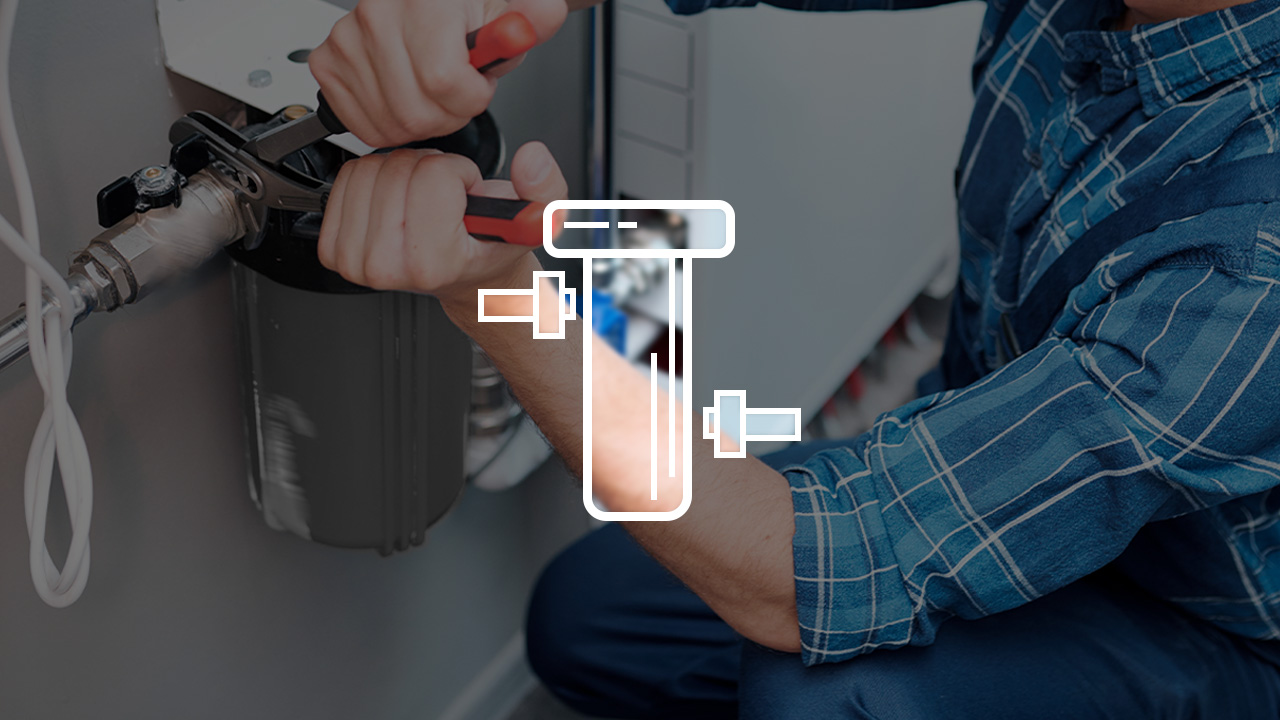Since pipe-mounted water filters are the most common in household use, many of our customers often ask how to install the device on their own without the help of a service team. In this text, you’ll find installation and maintenance algorithms for mainline filters, as well as information on potential installation issues.
Choosing a Mainline Filter
If you've landed on this page before purchasing a filter, let's talk a bit about the types of mainline filters, how they work, and the advantages and disadvantages of various systems.
Cartridge Filter Housing
A cartridge filter or "housing" consists of a plastic head with water inlet and outlet connections, which mount it to the pipeline. The plastic housing containing a cylindrical cartridge screws into the head. Water flows through the outer part of the cartridge, is purified as it passes through the filter material, and is routed through the inner part back into the pipeline.
Cartridges are made of various materials and perform different functions:
- For removing sand, rust, and other large particles, use cartridges made of spun polypropylene or tightly wound polypropylene thread.
- For improving water color, smell, and taste, use filter elements with granular or pressed activated carbon.
- To reduce specific contaminants like iron, manganese, and hydrogen sulfide, use cartridges with catalytic materials.
For an apartment with 3-4 people, a small 10'' cartridge housing should be sufficient. For larger households or private homes, consider 10'' and 20'' BB (Big Blue) housings. This applies to both carbon and catalytic cartridges.
Maintaining these devices requires systematic replacement of cartridge elements at least once every six months, which is the main drawback of this filter type.
The advantages of this device are clear:
- Wide functionality
- Simple construction and cartridge replacement
- Affordable price
Backwash Mainline Filter
The design and function of a backwash mainline filter for water are similar to a cartridge filter. However, instead of a porous or fill-type cartridge, it contains a mesh metal or plastic filter element. Water flows through this element from the outside, removing sand, rust, and other large particles.
Instead of cartridge replacement, this filter uses reverse or direct backwashing to flush contaminants from the filter element into the sewer. Sometimes, the filter element needs to be manually cleaned or replaced. Timely backwashing and the option for manual cleaning make the filter virtually everlasting. This is perhaps its main advantage. Another benefit is its compact size compared to cartridge housings.
The primary drawback is that the size of removable particles is slightly larger than in cartridge filters.
You can read more about the differences between backwash and cartridge filters, as well as their specific features, in a separate article. Now, let’s get back to the main topic and dive into the installation and maintenance of mainline filters.
Installing a Mainline Filter in a Metal-Plastic Pipe
- Prepare tools and rags or a container in case of water drainage from the pipes.
- Turn off the water supply at the inlet to the house or building, and release remaining water from the system by opening one of the faucets.
- Screw connecting fittings (preferably ½" unions) into the filter couplings using sealant.
- Hold the filter up to the wall and mark drill holes for mounting. Drill holes and insert dowels if needed.
- Attach the bracket to the filter housing. Pay attention to the arrow indicating the water flow direction.
- Secure the filter to the wall (ensure it’s well-fastened, as vibrations may loosen pipes, leading to leaks over time).
- Cut the pipe with a slight extra length for bending.
- Bend it using a pipe spring for flexible pipes and fit it to the filter (if too long, trim as needed).
- Calibrate the end of the pipe with a calibrator to ensure a round shape, which may be deformed during cutting. This prevents damage to the seals when inserting the fitting.
- Slide the nut and split ring onto the pipe.
- Insert the fitting into the prepared end of the pipe.
- Tighten the nut with a wrench until secure (avoid excessive force).
Note that compression fittings on metal-plastic pipes tend to loosen over time and may leak. For more durable connections, use press fittings, which involve the same steps but with a compression sleeve secured by a manual or hydraulic press tool, depending on pipe diameter.
Installing an Inline Water Filter in a Polypropylene Pipe
Repeat steps 1-5 from the previous section. Then:
- Mark the required length for the filter installation.
- Cut the pipe at a right angle with scissors.
- If applicable, remove the aluminum layer with a pipe scraper tool.
- Mark the welding depth.
- Heat the pipe and fitting with a pipe welding tool for 5-15 seconds depending on pipe diameter, and connect them as per the manufacturer's recommendations.
- Allow the joint to cool.
- Connect the filter by tightening the nut with a wrench, avoiding excessive force.
Installation of mainline filters in copper, metal, or other types of pipes varies based on the connection type and is less common. One additional tip: consider installing additional valves to simplify maintenance. Now, let's go over the cartridge replacement process.
Replacing Cartridges in a Mainline Filter
To replace the cartridge in a mainline filter housing:
- Turn off the water supply to the filter and release pressure from the system.
- Unscrew the filter housing using a special wrench and remove the used cartridge. We recommend doing this over a container or sink.
- Rinse the filter housing with running water. For stubborn dirt, use a dishwashing detergent.
- Place the rubber sealing ring in the groove of the housing and align it. If it’s damaged, replace it.
- Screw the housing with the cartridge tightly by hand without using the service wrench.
- Restore water supply and check for leaks.
If you have questions about the installation and maintenance of mainline filters, leave them in the comments. Remember, our service team is always ready to help quickly and efficiently install your mainline water filter, saving you time and effort.








